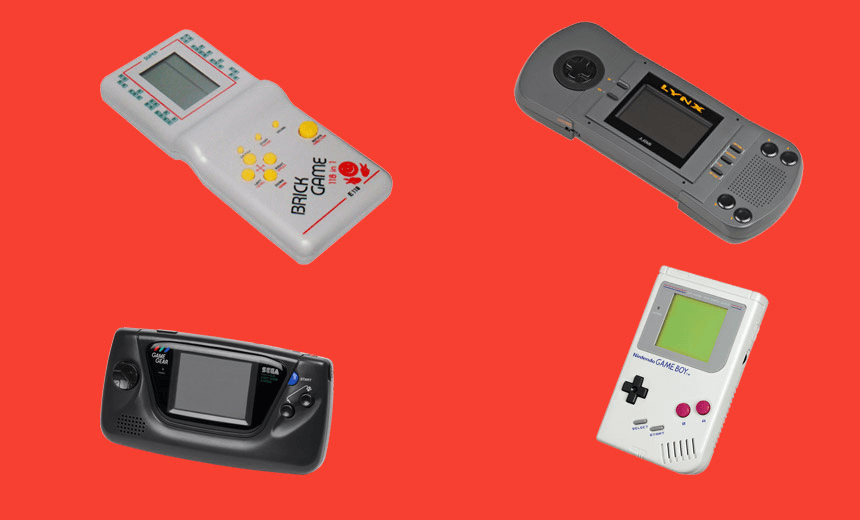Dan Taipua’s Save State series presents five gaming relics that every collector needs in their shrine/garage, from the essential basics to the very rare and frustratingly pointless. In the third installment, Dan lists his favourite hand-helds.
5. Sony PocketStation & Sega VMU
Look at these cute lil’ guys.
Portable systems are usually standalone devices, but these #5 gaming icons were developed as add-ons for the Sony Playstation and Sega Dreamcast respectively. Both operate as memory cards for saving game data, feature built-in digital clocks and sound, and stand at about 8cm high.
The Sega VMU is the more versatile of the two: when plugged into a Dreamcast controller it can act as a miniature second-screen, displaying real-time in game data. Unplugged from the Dreamcast, you can play minigames that give you XP and bonuses to upload to your save games. The mini games float at around the Tamagotchi level all way down to Nokia Snake. If you have two VMU’s you can even plug them end to end and swap data. The PocketStation isn’t as flash, but you can train FFVII Chocobo on it.
I think the basic idea with these is you can play them at school and contribute to something more meaningful in your life.
4. Atari Lynx
The Lynx is an okay gaming system but its really value is historical, marking the exact point Atari got washed-out. Best known for being the first and biggest video game company on earth, Atari was also the first to go bust. Between the Pac-Man era and the Lynx the company struggled for relevance with a bunch of different systems, and the portable market was one of the hardest battlefields they could have picked.
Every advantage the Lynx presented came with a downside: The large and wide screen gave it console-quality graphics but made the device barely portable with a 25cm width, and its speedy CPU gave it more processing power that in turn require more battery power (6x AA batteries at a time). One of the few upshot innovations for the Lynx is its ambidextrous function: you can flip the screen upside down and play with an opposite set of control buttons. The most portable feature of the Atari Lynx are the games, which came on hard chipboards instead of cartridges – though the games themselves were of middling or suspicious quality.
You could get the Lynx in New Zealand but it was a pretty rare sight – so secondhand prices are quite high.
3. Sega Game Gear
Despite the fact that the Game Gear has about the same technical specs of the Lynx, it made a much better showing in New Zealand. Part of this can be attributed to Sega’s marketing dominance in Western countries, which relied on a RAD BAD BOY ATTITUDE TO THE MAX. Sega global advertising was so bent on this angle that it even made it to Australia, culminating in this ginger boy with a single, solid curtain of bang. If that didn’t encourage you to fork over a small fortune, maybe the opportunity to have a mega radical fascist point a gun at your head would. By either means, Sega ensured that every badass 11 year-old in a Mighty Ducks cap and a silk shirt thought theirs was the better console.
The Game Gear shared the most important features of the Lynx: full-colour graphics and a back-lit display so you could play in the dark. Improvements included a reduced size (but still quite bulky), a much larger catalogue of games (about 300, many ported from the Sega Master System) and because this is Sega we’re talking about, a bunch of add-ons including a TV antenna.
There are two main factors keeping the Game Gear from a higher ranking in this list. First is the shockingly short battery life of 5-hours maximum per 6 AA batteries, meaning Energizer would eat up all of your disposable purchasing power. The second is the absence of a strong launch title to hook buyers, and one that would entice people entirely new to gaming; something like, say, Tetris…
2. Brick Game
This is a break in progression, but hear me out:
At any given point in time, the number of Brick Games in New Zealand exceeds the number of AA batteries by a factor of plenty. There might be more of these around than there are iPhones. What I’m trying to say is that Brick Game is very popular and there’s lots about and that. Brick Game consoles will often claim up to 999 playable titles, but there’s really only one: a cut-rate, cut-price, totally acceptable version of Tetris. This is the console’s only feature and only strength, and enough to earn the #2 place on this list.
Every now and then, there are certain games that re-orient the popular consciousness – games that allow people to make sense of what video gaming is and how it will function not only as product, but as a social object. Tetris was a benchmark for this kind of breakthrough because it presented itself as a puzzle instead of a video game. Everyone understands how a jigsaw works: the only additional mechanics are gravity and time. Novices can pick up Tetris and try it, experts can master it – a scalable experience for every audience.
As a console, the Brick Game helped re-orient perceptions about the social function of gaming i.e. an unobtrusive means of killing time. Console gaming meant occupying the family TV, and computer gaming meant confining yourself to indoors, but portable gaming meant filling in dead time: the bus stop, the waiting room, the kitchen of an unpopular relative. The sheer ubiquity of Brick Games, propelled by their low cost and availability from The Warehouse, introduced casual mobile gaming a generation ahead of of smartphones.
Never be shamed by your Brick Game, it belongs at Te Papa IMO.
1. Nintendo Game Boy
Back in the kingdom of proper portable consoles, the Game Boy wears the crown. Launching in 1989, before all of the other consoles listed above, the GB had the perfect formula for success and outsold, outlasted and generally stunted on every competitor.
Technically inferior to the Game Gear and Lynx, the Game Boy featured a square single-colour screen and reduced processing power, but 4 AA batteries would reliably last up to 20+ straight hours of gaming. The body of the Game Boy, designed by hall-of-famer Gunpei Yokoi, was much more compact than its competitors and subverted ergonomic expectations by going for a portrait orientation – placing the screen above the controls and mimicking a natural book-reading posture. The classic Game Boy DMG-001 console (pictured above) was so robust that it went unchanged for seven years until it was revamped as a more compact model, the Game Boy Pocket. The hardware continued to develop up to the Game Boy Micro in 2005, giving the brand a sixteen year history at the top of its field.
In 2012 I sold my original Game Boy to the NZ office of Vice Magazine. I had owned it for 20 years.
All our gaming coverage comes to your eye holes with help from Bigpipe, the grooviest ISP out there, yo.

